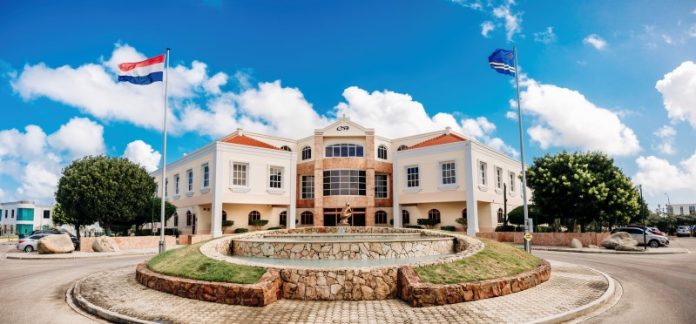During its meeting of December 10, 2021, and after reviewing the most recent economic and monetary data, the Monetary Policy Committee (MPC)[1] of the Centrale Bank van Aruba (CBA) decided to raise the reserve requirement rate[2] from 12.0 percent to 13.0 percent as of January 1st, 2022. This decision was primarily based on the elevated level of excess liquidity at the commercial banks.
The following information and analysis were considered in reaching this decision:
International reserves
International reserves (including revaluation differences of gold and foreign exchange holdings), up to and including November 19, 2021, increased by Afl. 561.5 million compared to the end of December 2020. The notable expansion in the international reserves was mostly the result of net inflows of foreign exchange reserves attributed to tourism services and loans from the Government of the Netherlands provided to the Government of Aruba (GoA) to improve its liquidity position. Meanwhile, official reserves increased by Afl. 330.7 million. Consequently, the official and international reserves reached, respectively, Afl. 2,538.6 million and Afl. 2,918.1 as of November 19, 2021 (Graph 1).
Accordingly, the level of reserves remained adequate when benchmarked against the current account payments and the IMF ARA[3] metric (Table 1).
Credit developments
In October 2021, total credit of the banking sector contracted by Afl. 88.9 million or 2.2 percent to Afl. 3,875.2 million, when compared to the end of 2020. This was driven by the categories ‘business loans’ (-Afl. 46.9 million/-3.1 percent) and ‘loans to individuals’ (-Afl. 25.0 million/-1.3 percent). The drop in the category ‘loans to individuals’ was driven by a decrease in ‘consumer credit’, while the category ‘business loans’ was for the most part impacted by less current account loans.
Inflation
In October 2021, the Consumer Price Index (CPI) rose by 2.4 percent, compared to the corresponding month a year earlier. The twelve-month average inflation rate amounted to -0.3 percent in October 2021, 0.4 percentage point higher than the previous month (Graph 2)[4]. The rise in the CPI compared to a year earlier was mainly the result of upward price movements in the components ‘transport’ and ‘household operation’. The former was related to the oil price hike resulting in a higher gasoline price, while the latter was likely due to global supply chain issues.
The aggregate excess liquidity of commercial banks rose to Afl. 1,295.8 million in October 2021, compared to Afl. 1,107.4 million in December 2020.
The monthly comparison showed, however, that the aggregated excess liquidity declined from Afl. 1,308.3 million in September 2021 to Afl. 1,295.8 millions in October 2021. This contraction was the result of the expansion of the reserve requirement rate from 9.0 percent to 10.0 percent as of October 1, 2021. The uptick in the reserve requirement rate was, however, mitigated by a surge in the total liquid funds[5] held by the commercial banks. Consequently, the level of excess liquidity remained high and is significantly above pre-pandemic levels.
The ample excess liquidity is partly the result of the reductions in the reserve requirement rate and the minimum prudential liquidity ratio as of March and April 2020, forming part of the monetary and prudential policy domains relief measures taken by the CBA to mitigate the effects of the COVID-19 pandemic. Furthermore, the continued subdued credit demand is an additional contributing factor to the commercial banks’ excess liquidity, and likely so were the wage subsidy and FASE programs of the GoA to counterarrest the economic effects of the COVID-19 crisis.
Consequently, the prudential liquidity ratio of the commercial banks, which measures the percentage of their liquid assets to their total net assets, remained at a comfortable level of 28.4 percent in October 2021, far above the minimum required prudential liquidity ratio of 18.0 percent.
Anticipated outflows due to the de-escalation initiatives by the CBA
Despite the comfortable level of official and international reserves, the CBA anticipates an increase in foreign exchange payments as a result of the lifting, as per September 2021, of the COVID-19 induced foreign exchange restrictions. The latest estimates show an outflow of Afl. 260.0 million by year-end 2021.
- The MPC was instituted in May 2010 to periodically evaluate and determine the monetary policy of the CBA. In addition, the MPC aims at improving the transparency of the monetary policy. ↑
- The reserve requirement refers to the minimum amount of reserves that commercial banks must hold at the CBA and is (currently) equal to 12.0 percent of their liabilities with a maturity less than 2 years. ↑
- The IMF ARA metric refers to “Assessing Reserve Adequacy Metric” from the International Monetary Fund, which measures the adequacy of official reserves by benchmarking these against a weighted average of broad money, intercompany lending, short-term and long-term debt, and export of goods and services. ↑
- “EOP” indicates End-of-Period inflation. The latter is the percentage change in the level of prices of goods and services, in contrast to the same period a year before. The 12-month inflation denotes the average percentage change in the prices of goods and services in the last 12 months, compared to the preceding 12 months. Meanwhile, the core inflation excludes the components of food and energy. ↑
- The total liquid funds of the commercial banks consist of the following items: cash, current account and time deposits held at the CBA, demand deposits and time deposits due from other commercial banks, short-term securities, government bonds, and other marketable securities. ↑




















